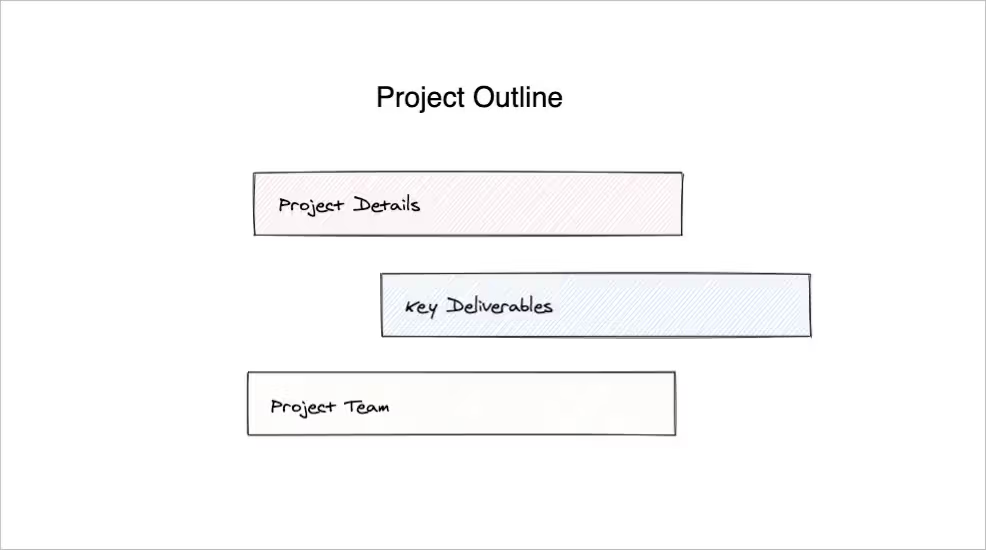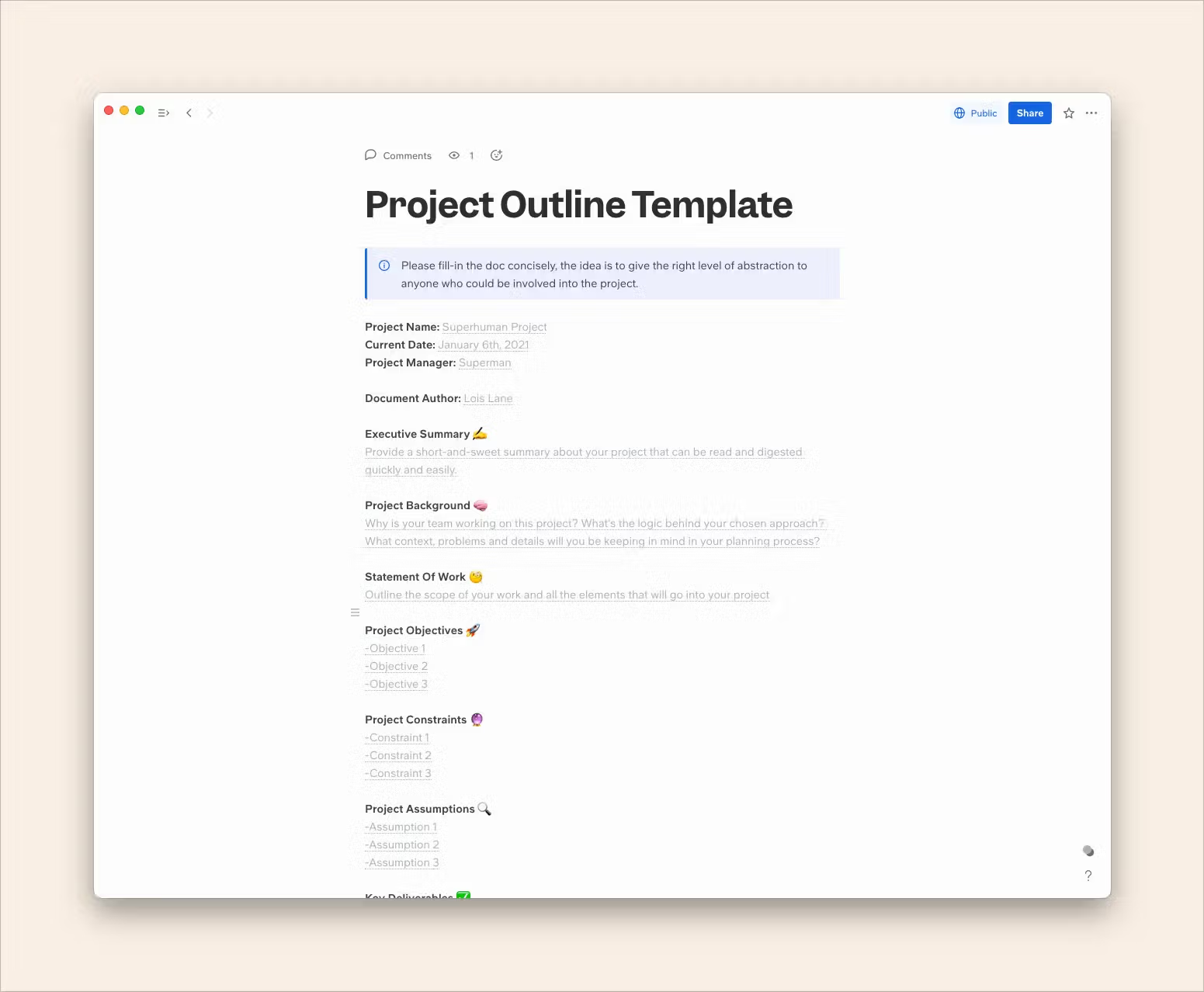What is a project outline?
A project outline is one of the fundamental documents used in the project planning and project management worlds. In essence, it's a simpler version of a project plan. Project plans are usually long, detailed and extensive, whereas project outlines are concise and to the point. They're comprehensive, but simultaneously bring together all the most important elements of project plans and present them in a brief, easily-digestible package.
Basically, project outlines offer an overview of your project at a glance. They're also a project manager's best friend as they serve diverse internal and external purposes. Whoever needs to be brought into the loop regarding a project can do so by reviewing its outline.

Who should create a project outline?
Most often, the main person in charge is the project manager. However, the people responsible for putting together a project outline also depends on the particular project's circumstances and whether it's being used internally or externally.
Depending on the situation, the project manager might consult team members, external service providers, clients, stakeholders, project sponsors, key decision-makers or other company personnel in the formation of their project outline.
If the project outline is being used externally as a project proposal, it will likely be presented by the project manager.
Where do project outlines fit into the project planning process?
Put simply, project outlines are like more concise versions of project plans. They're key documents in planning processes... even for the most simple projects. As such, they're most useful when they're put together at the beginning of your project's lifecycle. That way, they act as a kind of a roadmap for project managers and project teams alike.
It's particularly important to assemble an excellent project outline at the beginning of your planning process because they come in handy both internally and externally.
Externally, they can act as project proposals template and be presented to new clients, stakeholders, project sponsors and other key players. A killer project outline will help bring the right people on board to work on your project and even help secure resources and funding.
Internally, project outlines can help orient your project team when starting work on their next project. They help establish workflows, get people organized and foster efficiency in the early days of your planning process.
Create your own project outline for free
If you're about to get started on a new project or have new work coming down the pipe in the future, check out our free project outline template.
Forget about sharing links to countless Excel sheets and Google Docs. By using a Slite template, you'll be able to keep all the essential information that makes up your project outline in one easily accessible place.
Don't waste time starting from scratch when working on your next project. Our free template will help guide you when getting started and is easy to customize according to your individual needs and preferred planning methodology. It can also be updated in real-time, so it's easy to update throughout your project's dynamic lifecycle.

What are the main components of project outlines?
The beautiful thing about project outlines is that they'll look a little bit different according to your individual project details and needs. Nevertheless, project outlines include the following key elements:
- Basic information: Never underestimate the importance of having your project's key details available to refer to at any time. Include information such as project name, current date, project manager, team members and other key decision-makers and stakeholders.
- Executive summary: Provide a snappy, comprehensive overview of the project.
- Project background: Describe the context behind your new project, as well as why your team is working on it. Make sure to justify the approach behind your project management plan as a whole.
- Statement of work: Most importantly, account for your project scope. Outline which elements are included in your work and which elements aren't.
- Project objectives, constraints, assumptions, dependencies and potential risks.
- General project timeline: Include general timeframes, deliverables and other key metrics. Don't get bogged down in the details here and stick to rough dates and progress goals. This is sometimes stylized as a Gantt chart, especially for complex projects.
- Initial project budget & other key financial information.
Our top tips for writing a project outline
Writing an excellent project outline helps sets the right tone for your project and gets it off on the right foot. What do I have to do to put together a great project outline, you may ask?
There are various different possible approaches when starting a project outline, but the following tips will surely help you out regardless of the path you choose:
1. Consider various perspectives
In all likelihood, a variety of people will read through your project outline by the end of your project's lifecycle. To make sure it'll be easily understood by all those people, ensure that you consider various perspectives when putting it together. Ask yourself questions like: "What information will key stakeholders want to see included here?" and "What essential details do I need to include for my project team?"
2. Keep it simple
Don't fall into the trap of using overly embellished language and industry jargon. Ideally, you want your project outline to be easily understood by as many people as possible.Keep your writing clear and easy to digest. You want people to be able to look at your project outline and understand its key points with ease. If you’re unsure how to simplify your content effectively, looking at a well-structured compare and contrast essay example can offer insights into presenting complex information clearly and logically.
3. Brainstorm as a team
Here at Slite, we're passionate about teamwork and collaboration. The best way to pave the way to a successful project is to work together right off the bat. Two (or many) heads are better than one, after all. Assemble all your project's key players and ask for their feedback & contributions when getting started on your project outline. We can guarantee the result will be better for it.
4. Assemble a dream team based on strengths
Your project outline should come right at the beginning of your project planning process. Use the development of your project outline as an opportunity to put together an ideal team to work on your project. If you're a project manager or otherwise charged with a project, bring people onto your project team based on the strengths and abilities you know they'll bring to the job.
5. Be realistic
Project outlines are key project management tools that you'll refer back to time and time again, so it's important to keep them realistic. Don't be overly ambitious with your project goals, and don't commit to things you suspect won't end up being possible. Do your best to be truthful, accurate and pragmatic when it comes to the elements of your project outline. You (and your project team) will thank us later.
6. Establish a timeline
In the same vein, it can be easy to shy away from drafting a project timeline this early in the planning process. Nevertheless, we'd encourage you to include one in your project outline. It doesn't have to be anything extensive, but estimating rough dates and timeframes for key deliverables and milestones will help give early structure to your project.
7. Delegate away
Projects, especially big projects, can get complex... and fast. Take away some of those complications by starting to delegate tasks early on. Assembling a project outline is the perfect time to establish sub-committees and decide which team members should work on what. It's also a convenient time to determine if you need to hire any external service providers or contractors.
8. Determine scope... and stick to it
One of the most important parts of putting together a project outline is determining project scope. Project scope is vital in any project management process as it determines what is within the parameters or a project and what isn't. Make a point of determining your project's scope in your project outline development process... and stick to it!
Start your next project with a killer project outline
As you can see, project outlines are handy little documents that can help your project management process enormously when they're done right. They're useful to both internally and externally and act as handy guides that can be referred back to at any time while working on your project.
Investing a bit of time into assembling a well-done project outline at the outset of your project is well worthwhile. Whether you're working on one now or are planning to do so in the near future, referring back to this article (and our free template) will help you get started on the right foot in no time.

